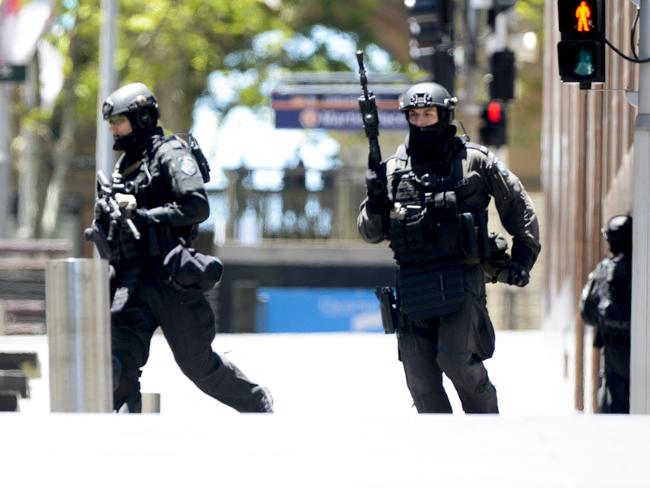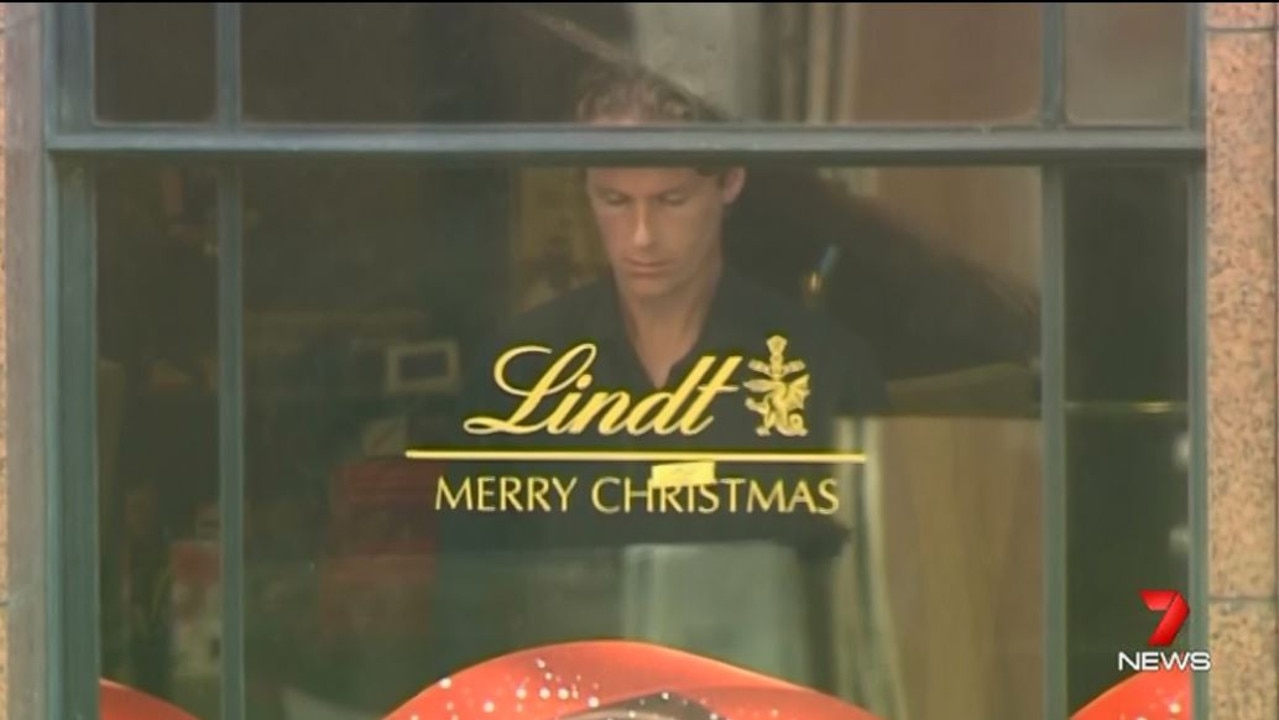ANY good cop will tell you the best time to execute an arrest warrant is at dawn — you can catch the crook with both their guard and their pants down.
In the early hours of the Lindt attack in Sydney’s west, black-clad officers with the Tactical Operations Unit had netted one of the alleged kingpins of a group targeted by the nation’s biggest counter-terrorism operation.
COPS’ FURY AT LINDT SIEGE INQUEST ‘WITCH HUNT’
Operation Appleby was run by the Joint Counter-Terrorism Team. It was directed at a group of 18 radical young Sydney men who had professed to be willing to die for Islamic State.
These men were the first suspects for the Linda cafe attack.

Within 20 minutes of Tori Johnson’s 9.41am triple-0 call from the Lindt Cafe, the order went out from the head of the state’s counter-terrorism squad — Assistant Commissioner Mark Murdoch — to track down every member of the group.
All that police knew about the Lindt gunman they were learning from Rosemary Birt, who had attempted to enter the cafe moments after the doors were locked, and Senior Constable Paul Withers.
With his bike parked down the hill in Martin Place, Withers yelled at everyone within earshot to get back.
Waving his arms, he made his way to the cafe, back to the wall for cover.
Hugging the wall, he moved around into the Martin Place foyer.
Using one of the door columns for cover, he saw Marcia Mikhael and barista April Bae, tears coursing down their cheeks, standing at the double glass doors looking out of the cafe, their hands on the glass.
With gestures and mouthed words, Withers and Mikhael silently communicated the fact there was a single gunman and he was standing to her right.
After a couple of minutes, Withers was called away by his duty officer.
Unhappy at the order, he pointed to his name tag and mouthed: “I’ll be back.”

The centre of Sydney was already in lockdown with Martin Place station and the Eastern Suburbs rail line closed and air space over the city blocked off as buildings surrounding the cafe, including Parliament House and the NSW Supreme Court, were evacuated.
Bomb teams were on their way to search George St and Circular Quay.
Withers borrowed a bullet- proof vest and persuaded his superior to let him return.
He reported back that in the cafe he could see a man, age early 50s, beard, carrying a sawn-off shotgun. His right hand was on the trigger.
Significantly, Withers reported the man had a backpack with a wire coming from it.
Pulled away again, the police officer mouthed to the two women: “It will be OK. Stay calm,” and simulated deep breathing.
It was the last unsupervised contact any of the hostages would have from inside the cafe with the police for the next 17 hours.
The weapon cradled in his arm, the gunman used it to point everyone over to the windows looking out to Martin Place.
Julie Taylor and her friend Katrina Dawson were unsure what to do and stayed where they were.
Dawson caught his eye.

Amazingly, the hostage taker told them they could go, but Dawson wasn’t going to leave her fellow barrister Stefan Balafoutis behind: “Can he come with us?”
With their hands in the air, the trio walked to the Phillip St doors but the gunman appeared to change his mind:
“No. All of you. Stand there next to the door.”
Balafoutis thought they should run for it. Taylor disagreed.
They stayed.

By then, the man had unfurled his black Shahada flag and made the hostages hold it up at the cafe windows in scenes that were flashed around the world.
The image was made even more chilling by an order that the hostages keep their eyes closed.
The TOU officers, most of whom had now been on duty since dawn, had grabbed their 25kg of gear including bulletproof vests, M4 semiautomatic M4 calibre rifles with spare magazines and stun-grenades.
In the armoured vehicle on their way to the cafe, the first of what was to be a series of bungles occurred.

An officer codenamed Officer A was fitting a magazine of 30 bullets into his M4 when they went over a speed bump and the rifle didn’t load correctly.
He took one of the bullets out, put it in his pocket and reloaded the magazine with 29 bullets.
They had been having problems with the new magazines holding a full complement of bullets since they were delivered six months earlier.
Other than that, the police machine was swinging into action, even as it turned out to be more than a little squeaky.
At 9.49am, one of the police on-call negotiators codenamed Reg, a detective senior sergeant, received the text message: “Heads up hostages being held at Lindt chocolate.”
His boss “Graeme”, a detective chief inspector, was in the office and within five minutes had the whole negotiation team on its way.
Their negotiation truck, an anonymous white pantech Isuzu, had been destroyed by lightning in 2011 and never replaced.
They spent the first three hours of the country’s first terrorist siege operating out of the back of a 4WD.

From the start, police put in place what was then their automatic strategy of “contain and negotiate”.
At 10am, the chief inspector codenamed Tango Charlie, who was tactical commander during the entire siege, arrived at the forward command post.
The post, commanded by Supt Sicard, looked after the on-the-ground police action.
A former head of the NSW Police TOU and a 30-year special forces commando veteran who had done a tour of Afghanistan, the first thing Tango Charlie did was to have a so-called Emergency Action plan drawn up.
That job fell to the TOU officer codenamed Officer B.
Widely regarded as a last resort and called “going in dirty”, the plan would be triggered as per their training by the death, serious injury or imminent death or serious injury of a hostage.
That was the early plan anyway.
Another TOU officer was given the task of drawing up a so-called Deliberate or Direct Action plan under which police would assault the cafe at a time of their own choosing to take the gunman by surprise.
This was their preferred resolution. It was not lost on any of them that if they had to storm the cafe under either plan and the gunman was armed with a bomb then the lives of the hostages and their own would be on the line.
By 10.30am, the first of the snipers, codenamed Sierras, arrived with their Remington 700 bolt-action rifles.
There were three teams and they chose their positions in the Channel 7 building, the Reserve Bank and the old Westpac Bank building in Martin Place, from where their main role was to be the eyes of the police into the cafe.
Unless they got the chance they were itching for — to legally take a shot.
The strategy was to slow things down until police could work out what was going on inside the cafe.

By 10.47am, Murdoch was told all the Operation Appleby targets had been accounted for.
The gunman’s identity remained unknown.
The Lindt Cafe siege had taken over the TV channels with blanket coverage.
Watching was Michael Klooster.
The court case he had rushed to earlier had been over in 10 minutes.
In the blurry footage from inside the cafe, viewers could catch a glimpse of the gunman and Klooster was probably the first person to mention his name — he thought it was his former client Man Haron Monis.
It would be 2.17pm before he called the Federal Police to alert them.
At 10.55am, then NSW premier Mike Baird was being briefed on the worst possible news. Australia’s first terrorist siege was under way.
Then at 11.07am Assistant Commissioner Mick Fuller made a call that may have changed the course of history.


Add your comment to this story
To join the conversation, please log in. Don't have an account? Register
Join the conversation, you are commenting as Logout
Peak-hour chaos: Car fire closes M5 tunnel
A car fire has forced the closure of the M5 East Cooks River Tunnel citybound at Mascot, with police attributing the blaze to a mechanical fault.
Teen rider seriously injured in crash after police chase
A 19-year-old man is in a serious but stable condition after crashing an unregistered motorcycle during an alleged police pursuit in Cranebrook.